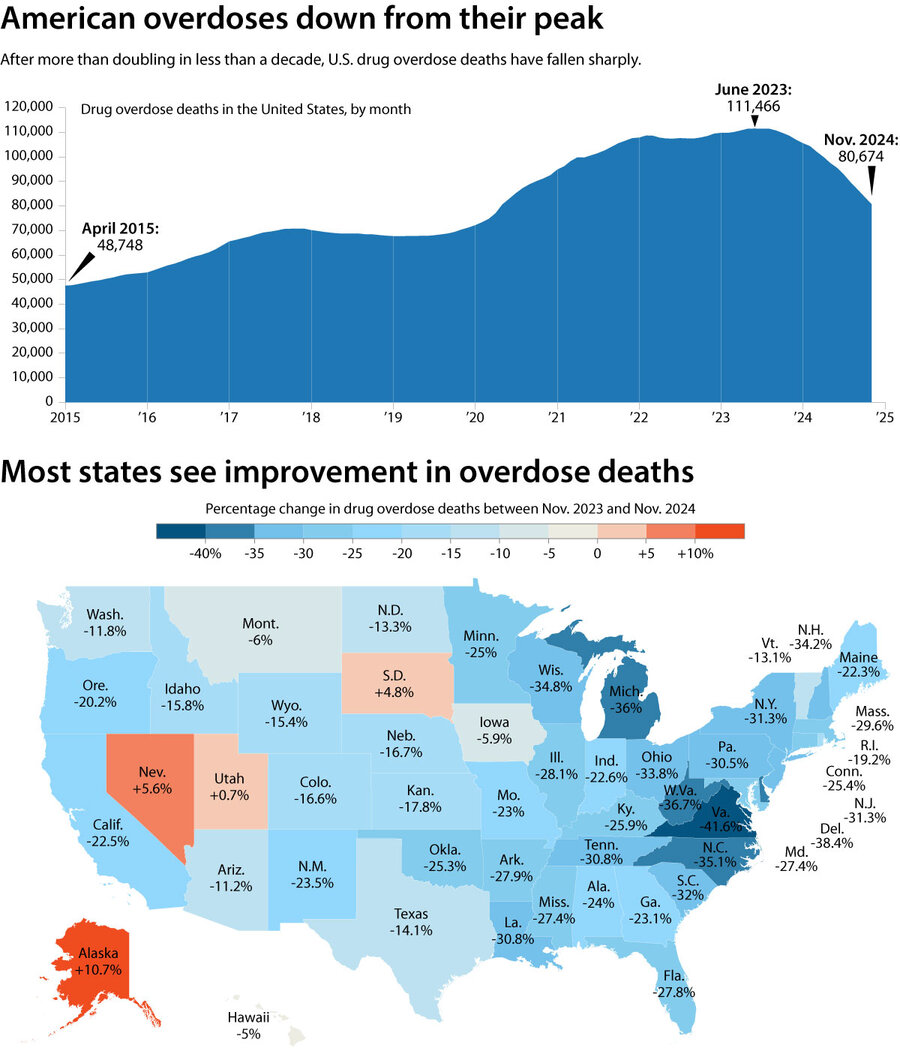The United States is seeing a sudden drop in overdose deaths.
The country saw a 25.7% decline in drug overdose deaths in 2024 compared with the previous year, according to the Centers for Disease Control and Prevention. It was the lowest number of overdose deaths in a 12-month period since 2020.
Some 46 states reported a decline from 2023 to 2024. Virginia observed the most drastic reduction in deaths – a 41.6% decline. (Delaware followed with a 38.4% decrease and West Virginia reported a 36.7% decline.) California, which is the largest state by population and records the most overdose cases, saw a 22.5% year-to-year decline.
Why We Wrote This
A story focused on
After years of epidemic, the good news on overdose deaths is both pronounced and widespread. Not only did 46 states report a decline, the total number of deaths dropped by more than 27,000 in one year.
But public health experts are pausing before sounding any victory bells.
“This is a really important moment to pay attention to the trends. Not to declare victory, but to increase our commitment to working together on this,” says Howard Koh, professor of public health leadership at the Harvard T.H. Chan School of Public Health.
“We need the current administration to step up and accelerate the momentum and not cut back its commitment through funding cuts and laying off public health workers at the state and federal level,” says Dr. Koh.
There are many concurrent factors that contributed to the drop in overdose deaths.
Some prevailing theories include: the increased accessibility of naloxone, which can reverse the effects of an overdose; increased access to evidence-based treatment for substance abuse disorders; and resumption of services after pandemic-related disruptions. Shifts in the illegal drug supply may also have played a role.
“Overall, there’s more attention to public health and public safety to work together to address the crisis,” says Dr. Koh, who served as a senior public health adviser during the Obama administration. “We’ve learned we can’t arrest our way out of this problem.”
In 2017, the U.S. Department of Health and Human Services declared the opioid crisis a public health emergency. The pandemic worsened the situation, with a surge in overdose deaths due to isolation and increased fentanyl use. At its peak in 2022, nearly 108,000 people died from overdose, according to the National Institute on Drug Abuse.
“It is unprecedented to see predicted overdose deaths drop by more than 27,000 over a single year,” said Allison Arwady, director of CDC’s National Center for Injury Prevention and Control, in a press release. “That’s more than 70 lives saved every day.”
However, public health experts like Dr. Koh remain “cautious but hopeful” that the downward trend continues.
“This is not the time to take the foot off the pedal,” he says.








